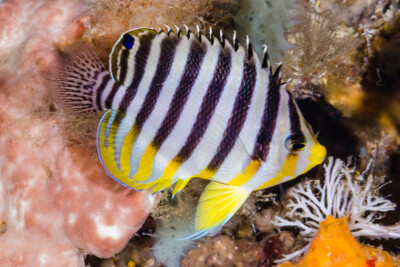Introduction
Upeneus tragula is a salt water fish.
This sheet is currently being prepared. The texts currently proposed come from our data model or are being drafted. To request priority for this content, you can write to us HERE.
Who is it?
Morphology
-
Average size20 cm
-
Maximum size30 cm
-
Patternrayure horizontale
-
Average size20 cm
-
Maximum size30 cm
-
Patternrayure horizontale
How to recognize This fish ?
This fish has the particularity to possess several pairs of barbels, which allow him to search the bottom and to detect the food thus moved.
Upeneus tragula measures between 20 and 30 cm. This fish is multicolore with a predominantly rouge, noir, blanc and beige body. The also has rouge rayure horizontale.
Behaviour & Life cycle
-
dietcarnivorous
-
Sociabilityliving in shoals
-
territorialNo
-
Way of livingdiurnal
Upeneus tragula is a fish living in shoals naturally found on the bottom. This species is carnivorous .
Although Upeneus tragula is non-territorial, it is sometimes aggressive towards other species.
Reproduction
-
Reproductionovipare
Upeneus tragula is a fish ovipare.
Harmless species
This species does not represent any particular threats to humans when encountered in its natural environment.
Origin and distribution

What is its habitat?
Natural environment characteristics
-
Temperature25 - 29 °C
-
Depth0 - 42 m
Biotope presentation
Upeneus tragula is most often found at a depth between 0m and 42m. However, it is not impossible to find this species at other depths.
Species of the same biotope
To go further
Sources & Contributions
Participation & Validation
The Fishipedia team and specialist contributors are committed to providing high-quality content. However, although the information comes from scientific sources or testimonials from specialists, the cards may contain inaccuracies.

Adrien Falzon
Translation
Translation done with the valuable contribution of our translators, who make this information available to a wider audience. We sincerely thank them for their commitment.
Scientific partners
Tags
Species of the same family
Species of the same biotope




























